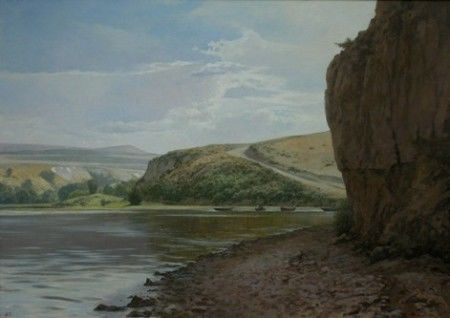Andrey Soldatenko
Oil on canvas
Oil painting, especially in the first pair, a complex process. But after some obvious things are still clear, oil painting is much more pleasant. In this technique work is very interesting. The process of search and experimentation never stops. Ways of working in this technique a lot. And feel the freedom when their master.
Techniques for the different processes of oil painting
When the artwork painter should have as a goal: to fulfill his plan most sophisticated technical means.
Materials used in oil painting, composition and properties are very complex and varied, so the most effective and proper use artist must have known of knowledge and follow a certain system in the construction of the paint layer.
There are many different systems of painting, but the most common of them, especially after prolonged use, this multi-layered.
In a multilayer system of the whole process works is divided into separate major phases, performed in more or less definite sequence: 1) shading the soil, 2) design, 3) application of the basic colors, 4) parts, 5) glaze; 6) completion.
Toning soil
The color of soil is of great importance, because of it depends largely on the effect of color pictures. A beam of light passing through layers of transparent colors and falling to the ground stained, partly absorbed, partly reflected and come to the surface of the picture painted in a color, depending on the color of the soil and transparent paints.
Rembrandt preferred primer-colored slate, Rubens - a red-brown and umbristy, Matveev - brown soil, podmalevyvaya his grisaille, Levitsky - neutral-green color of soil, Borovikovsky enjoyed neutral gray primer applied Bryullov light brown, Alexander Ivanov tinted primer light ocher, Repin wrote on the white ground, Surikov also enjoyed the white bottoms, performing drawing in cold tones.
Drawing figure
Preparing a drawing or separately on paper and then translating to canvas, or directly on the canvas.
Applying basic colors
Underpainting as a general outline is the first layer of paint in the painting, which aims to establish a pattern, the overall color and thus facilitate and create training for further propisok.
Underpainting write a thin layer, as in the light, and in the shadows skorosohnuschimi paints, varnishes and diluting them with solvents to the dry could continue to work in a few days.
Multi-layered method of painting based on the principle of optical mixture of colors gives you a wide variety of colors and shades of colors, protects against the harmful effects of colors on each other, what happens when the usual method of mixing them, and facilitates the technique work on the creation of highly artistic works of art, as well as provides long-term preservation of paintings.
Application scumbling refers to very remote times. Oil paints and varnishes are great possibilities of using this technique in easel painting.
Step scumbling due to the fact that the underlying solid paint reflects the rays are attached to the rays of transparent paint.
If the red cadmium prolessirovat kraplakom, we get the impression of intense pure and deep tones.
STAINING, passing through a light, absorbs additional colors. For example, kraplak absorbs green rays, Prussian blue - red-yellow, on the surface, thus, goes part of the colored rays, without any admixture of white.
When laying consistently the dark podmalevku additional glaze colors such as burnt Sienna and ultramarine, a thorough dark tone.


